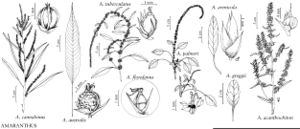Difference between revisions of "Amaranthus australis"
Madroño 13: 15. 1955.
FNA>Volume Importer |
FNA>Volume Importer |
||
| Line 8: | Line 8: | ||
}} | }} | ||
|common_names=Southern water-hemp;southern amaranth | |common_names=Southern water-hemp;southern amaranth | ||
| − | |basionyms={{Treatment/ID/ | + | |basionyms={{Treatment/ID/Basionym |
|name=Acnida australis | |name=Acnida australis | ||
|authority=A. Gray | |authority=A. Gray | ||
| + | |publication_title=Amer. Naturalist | ||
| + | |publication_place=10: 489. 1876 | ||
}} | }} | ||
|synonyms={{Treatment/ID/Synonym | |synonyms={{Treatment/ID/Synonym | ||
| Line 60: | Line 62: | ||
|publication year=1955 | |publication year=1955 | ||
|special status= | |special status= | ||
| − | |source xml=https://jpend@bitbucket.org/aafc-mbb/fna-data-curation.git/src/ | + | |source xml=https://jpend@bitbucket.org/aafc-mbb/fna-data-curation.git/src/f6b125a955440c0872999024f038d74684f65921/coarse_grained_fna_xml/V4/V4_812.xml |
|genus=Amaranthus | |genus=Amaranthus | ||
|subgenus=Amaranthus subg. Acnida | |subgenus=Amaranthus subg. Acnida | ||
Revision as of 20:02, 24 September 2019
Stems erect, branched, stout to robust, usually 1.5–3 m (occasionally to 9 m!) × 30 cm. Leaves: petiole 1/3–2/3 length of blade; blade narrowly lanceolate to narrowly ovate, 10–20 × 1–4 cm, base cuneate, margins entire, plane, apex acute or long-attenuate to acuminate. Inflorescences mostly terminal, linear spikes to panicles, usually interrupted. Bracts: of pistillate flowers 1.5–2 mm; of staminate flowers with moderately heavy midribs, 1.5–2 mm. Pistillate flowers: tepals absent; style branches spreading; stigmas 3–5. Staminate flowers: tepals 5, inner tepals with moderately prominent, excurrent midribs, equal, 2–2.5 mm, apex subacute to mucronulate; stamens 5. Utricles stramineous to brown, with 3(–5) longitudinal ridges corresponding to 3–5 style branches, elliptic or obovoid, 1.5–2.5 mm, slightly fleshy, smooth (slightly rugose in herbarium specimens). Seeds reddish brown to dark brown, 1–1.2 mm diam., shiny.
Phenology: Flowering summer–fall.
Habitat: Freshwater and brackish wetland habitats, coastal marshes, swamps, riverbanks, bayous, canals, ditches, estuaries, lakeshores, hammocks
Elevation: 0-100 m
Distribution
Ala., Ark., Fla., Ga., La., Miss., N.C., Tenn., Tex., Va., e Mexico, West Indies, n South America.
Discussion
Plants of Amaranthus australis, a herbaceous annual, can be amazingly tall, with a single hollow main stem, up to 9 m, and the stem base can reach 30 cm in diameter. Large plants may somewhat resemble young trees of Taxodium distichum var. imbricarium, pondcypress.
Selected References
None.
